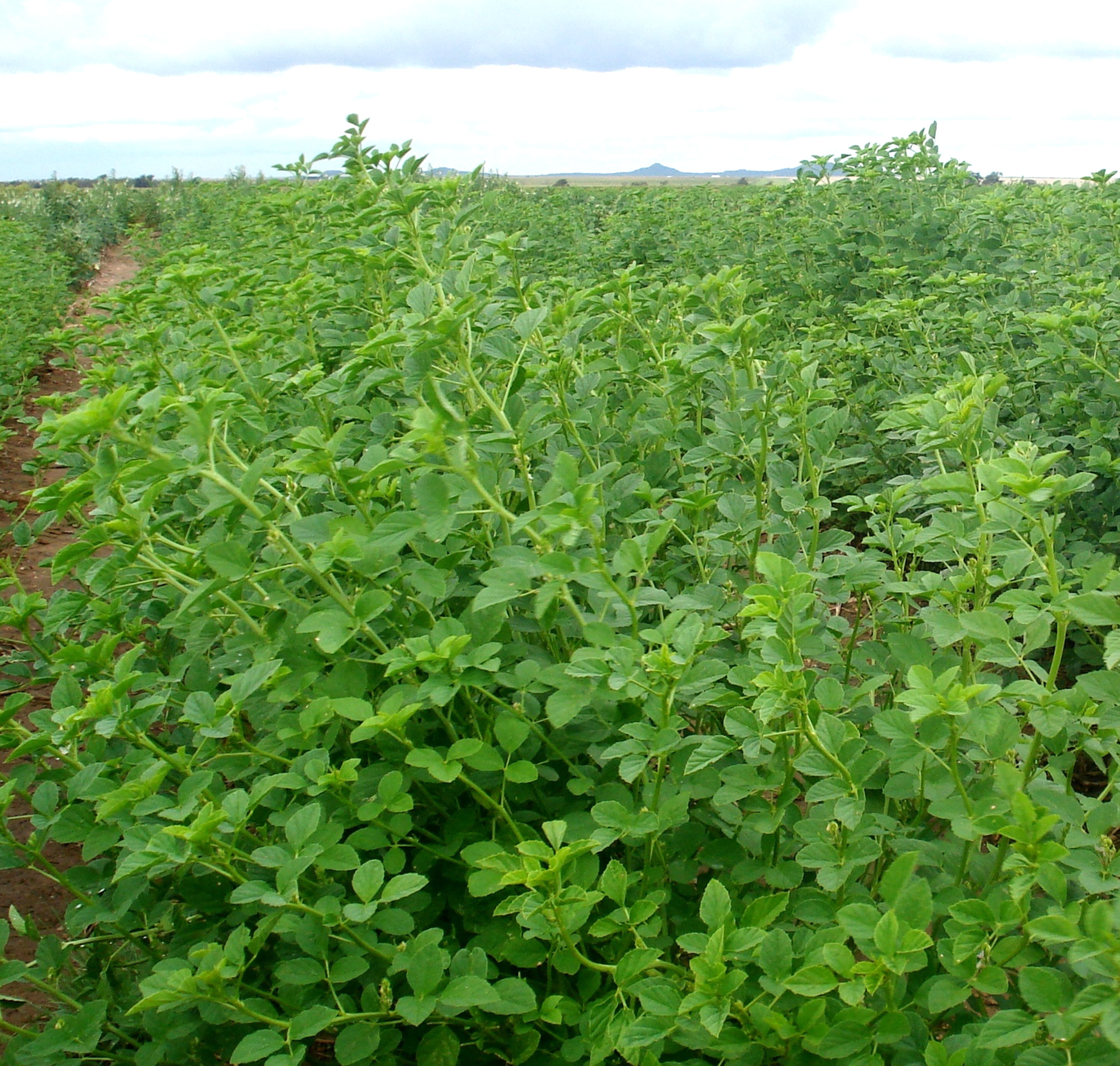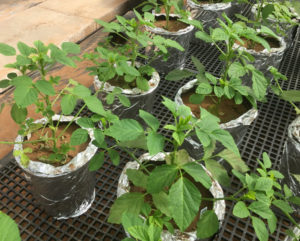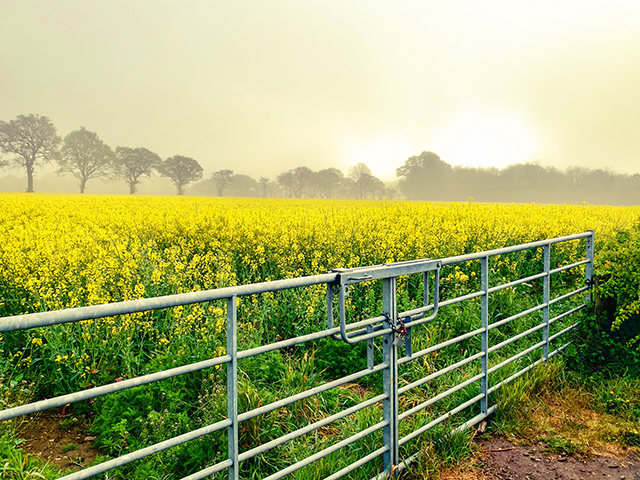Farm & Ranch
[AgriLife Today] Study sheds light on nodulation in legume crop guar

By: Kay Ledbetter
Writer: Kay Ledbetter, 806-677-5608, [email protected]
Contact: Dr. Curtis Adams, 940-552-9941, [email protected]
VERNON – Texas A&M AgriLife scientists are conducting several research projects to improve producers’ understanding of guar and the legume’s value to their operations in the Rolling Plains and South Plains.

Dr. Curtis Adams, Texas A&M AgriLife Research crop physiologist, Vernon, tested the effects of contrasting soils, a sandy loam and a clay loam, and Rhizobium inoculants on nodulation and plant growth in two guar varieties in the greenhouse. (Texas A&M AgriLife photo by Dr. Curtis Adams)
Guar has been grown in Texas for more than a century, but acreage of the crop in the state is relatively low, said Dr. Curtis Adams, Texas A&M AgriLife Research crop physiologist in Vernon,
Lack of nodulation on guar roots is one of the producer concerns addressed in a recent AgriLife Research study by Adams and Dr. Calvin Trostle, Texas A&M AgriLife Extension Service agronomist in Lubbock, along with Dr. Santanu Thapa, AgriLife Research postdoctoral research associate in Vernon.
Nodulation is the process of forming nodules on the roots of legume plants. Nodules are root structures that legumes make to house bacteria capable of using nitrogen gas from the air to form fertilizer that the plant can use to grow.
The team conducted a controlled environment study to compare the impact of environmental and management factors on guar nodulation and crop nitrogen uptake, Adams said.
Guar is grown in semi-arid regions and produces a seed containing galactomannan gum, which is a product used in a variety of food and industrial applications as a lubricant, binder, thickener or hardener, he said.
“As a legume, Rhizobium bacteria in the soil will associate with guar roots and potentially develop nodules where the bacteria converts atmospheric nitrogen into fertilizer for the plant and soil,” he said, adding that “the plant is also drought tolerant and uses relatively little water.”
Thapa said guar is unfamiliar to most people, but it is a part of their lives nonetheless.
“Guar gum is a common ingredient in the food we eat every day,” he said. “It is used extensively in oil and gas exploration, and in so many other ways.”
The majority of the world’s guar is grown in India and Pakistan, and the U.S. has had variable and relatively low acreage over time, Trostle said. In the U.S., guar is mostly grown across the Southern Great Plains region where the climate is suitable.
“Guar being a legume and adapted to a semi-arid region’s dryland agriculture is important,” Trostle said. “There are few legumes that would be adapted in this type of environment. That is why this work is especially important, to get potential nitrogen fixation in a legume rotational crop where it doesn’t rain a lot.”
Adams said despite the potential nitrogen benefits of the crop, there is a worldwide perception that guar does not nodulate effectively.
“So, we tested the effects of contrasting soils, a sandy loam and a clay loam, and Rhizobium inoculants on nodulation and plant growth in two guar varieties,” he said.
Although Rhizobia bacteria often occur naturally in soils, Rhizobium inoculants are crop-specific bacterial cultures prepared in the lab and applied to the seed or in-furrow at planting to increase the likelihood of root nodulation, Adams said.
He said because guar acreage is not large in the U.S., there is a lack of inoculant products specific to guar.
“In our study, we tested one commercially available inoculant and a custom inoculant prepared by a microbiologist colleague, both containing bacterial strains thought to create nodules on guar roots that fix nitrogen,” he said.
Thapa said two iterations of the 50-day study were run in 2017. Plant growth, plant nitrogen concentration, measures of yield potential, root nodule number, nodule weight and other parameters were determined.
“The results of this study clearly showed in different soils that guar is capable of producing plenty of nodules,” Adams said. “The soils we tested are representative of the semi-arid soils on which guar is produced around the world.
“We saw very different nodule characteristics in each soil, with a high number of nodules of low weight in the clay loam soil and low number of nodules with high weight in sandy loam. In the end, the amount of nitrogen supplied to the plants was similar between soils.”
The difference in nodule characteristics between the soils may have resulted from differences in Rhizobia population already in the soil, Adams said.
The study showed no effect of the inoculants on the number or size of nodules or plant nitrogen uptake, Thapa said.
“We are not sure why the inoculants had no effects, but it likely has to do with survival or competitiveness of the inoculant bacteria, or naturally occurring levels of Rhizobia in the soil,” he said.
“Based on the results of this study, we expect guar will nodulate and supply nitrogen in the field, as long as the conditions are right,” Adams said. “Factors like drought or low soil levels of Rhizobia bacteria could prevent nodulation.”
But little is known about the effects of external factors on guar nodulation, he said, so there are still many questions to answer.
Trostle said recent discussion with an inoculant manufacturer may provide AgriLife the opportunity to work with experimental products to expand biological nitrogen fixation in semi-arid dryland agriculture.
Trostle said four additional federally funded projects, three led by AgriLife Research, are aimed at providing more information for producers on guar in relation to guar agronomics, wheat rotation, plant breeding/adaptation and bioenergy.
And, he said, if the production builds up, Texas growers of guar seed have a market in Brownfield. The guar is processed into several different products, either for supplying specialty manufacturers who do their own refining or direct use in commercial products.
-30-
Find more stories, photos, videos and audio at http://today.agrilife.org
Farm & Ranch
Land Market Report: March Land Sales

By Jared Groce
Rural land sales are continuing on a steady pace for early spring, with prices holding very strong with the sell-to-list price ratios remaining very high, even on properties that have been on the market for a longer than usual time period. The total number of transactions are picking up once again as the spring selling season kicks off, and the average acreage continues to decrease.
Larger acreage properties seem to be in higher demand than smaller properties currently, with many buyers simply parking cash in real estate to hedge against inflation. Interest rates seem to have settled down and most experts agree that rates will be reduced by the fed this year. Some lenders have programs in place that allow the buyer to reduce their rates without having to go through a full refinance ordeal.
To read more, pick up a copy of the May issue of NTFR magazine. To subscribe by mail, call 940-872-5922.
Farm & Ranch
Texas FFA State Vice President Weston Parr

Future Farmers of America was founded by a group of farmers in 1928 with the mission of preparing the next generation of agriculture. It has done just that during its 95-year history, as the organization works to give back to others by following its motto, “learning to do, doing to learn, earning to live, living to serve.”
FFA is an organization made up of state associations, and at the helm of the Texas FFA is a team of 12 officers representing their respective areas within the Lone Star State. These individuals dedicate a year of their lives as they serve members, provide leadership, and work together with the state staff and board of directors to develop policy and lead the organization of over 177,000 members.
North Texas is represented by Area IV and Area IV, stretching from Wilbarger County to Bell County and from Runnels County to Grayson County. This year, those chosen to lead this great area are State President Isaac Hawkins Jr., Area IV, and State Vice President Weston Parr, Area V.
Parr is from the Sam Rayburn FFA chapter and the Area V Association, but the leader who now serves more than 19,100 members of Area V entered the FFA organization as a shy teenager who sat in the back of the room.
“I didn’t talk to a whole lot of people. I didn’t know what I wanted to do with my life or where I could see myself, so I wasn’t involved on my high school campus,” Parr recalled.
“Then I started FFA and slowly but surely, my ag teachers worked me into attending more contests, meeting new people, and speaking. I remember the first time I gave an officer speech to my chapter. I can still remember how embarrassing it was. To see the progression from that moment to speaking on stage at the state convention in front of thousands of people. Now I feel like I can enter the industry I want and be successful all because of what FFA afforded me for five years.”
There is not much Parr did not do during his time in high school. His contest participation included chapter conducting, wool judging, cotton judging, wildlife, and job interview, but his favorite was extemporaneous speaking, which he did not start until his senior year of high school.
“I wish I could go back to my freshman, sophomore, and junior years and start that sooner. I think if I had more time, I would have been more successful than I already was, but that was something I didn’t realize I liked at the time. I’m not naturally somebody who likes to speak in public, but it was actually my favorite,” Parr said.
Parr won several awards during his time competing. In 2023 alone, Parr earned the Texas FFA Service-Learning Proficiency title, was a National FFA Service-Learning Proficiency finalist, and a Texas FFA Extemporaneous Speaking finalist. In addition to his CDE and LDE events during high school, he showed commercial steers at Houston, and boilers at most major shows, participated in the county show with projects in ag mechanics, showed goats from time to time, and showed heifers until graduation.
“FFA provides invaluable resources and knowledge to be successful once you leave high school and you are out of the blue jacket for the first time. I have been a part of a lot of great organizations over the years, and they are all great in their own way, but in my opinion, FFA is the most successful at producing members of society who want to go and do something with themselves,” Parr said.
He was halfway through his time as Area V Association President and attending the national convention when he began to ponder the idea of running for state office.
“This is around the time when you usually figure out if you want to go through and be a state officer or you decide that area officer is your last run. I was unsure of where I wanted to go, but I knew I didn’t want to be done with FFA. I decided maybe it would be a good opportunity not only for me to make more friendships and connections, but also to give back to the program that allowed me to be able to do what I can do today,” Parr explained.
To read more, pick up a copy of the May issue of NTFR magazine. To subscribe by mail, call 940-872-5922.
Farm & Ranch
Texas FFA State President Isaac Hawkins, Jr.

FFA is an organization made up of state associations, and at the helm of the Texas FFA is a team of 12 officers representing their respective areas within the Lone Star State. These individuals dedicate a year of their lives as they serve members, provide leadership, and work together with the state staff and board of directors to develop policy and lead the organization of over 177,000 members.
North Texas is represented by Area IV and Area IV, stretching from Wilbarger County to Bell County and from Runnels County to Grayson County. This year, those chosen to lead this great area are State President Isaac Hawkins Jr., Area IV, and State Vice President Weston Parr, Area V.
These young leaders share a drive to give back to the organization that has given to them as they work to support FFA members while preparing for a future in the agricultural industry.
From the 12 selected representatives, delegates elect a president and first vice president, with the remaining 10 serving as vice presidents from their respective area associations. The selection process consists of a popular vote by delegates at the state convention, which accounts for 40 percent of the decision, and a committee process that includes a written knowledge exam, worth 10 percent, and an interview, accounting for 50 percent. This year, after all was said and done, Hawkins was named this year’s Texas FFA President.
Hawkins grew up as part of a large, blended family with five sisters and three brothers. While he says he did not grow up in agriculture, his youth was spent outside fishing and doing all things outdoors with his father, whom he calls his best friend. As he entered Hirschi High School in Wichita Falls, Hawkins knew he wanted to be a vet but was unsure of what courses to take to set himself on that path.
“I signed up for ag principals just because they had animals in the description. The first day of class we talked about churning butter, and I went to my school counselor that same day and told her to change my schedule immediately, but she refused. She made me stay there,” Hawkins laughed. “Luckily, I had an incredible ag teacher, and she really helped me to fall in love with the program.”
To read more, pick up a copy of the May issue of NTFR magazine. To subscribe by mail, call 940-872-5922.
-

 Country Lifestyles1 year ago
Country Lifestyles1 year agoScott & Stacey Schumacher: A Growth Mindset
-

 Equine7 months ago
Equine7 months agoThe Will to Win
-

 Country Lifestyles7 years ago
Country Lifestyles7 years agoStyle Your Profile – What your style cowboy hat says about you and new trends in 2017
-

 Country Lifestyles4 years ago
Country Lifestyles4 years agoAmber Crawford, Breakaway Roper
-

 HOME7 years ago
HOME7 years agoGrazing North Texas – Wilman Lovegrass
-

 Country Lifestyles7 years ago
Country Lifestyles7 years agoDecember 2016 Profile, Rusty Riddle – The Riddle Way
-

 Country Lifestyles8 years ago
Country Lifestyles8 years agoJune 2016 Profile – The man behind the mic: Bob Tallman
-

 Outdoor9 years ago
Outdoor9 years agoButtercup or Primrose?






